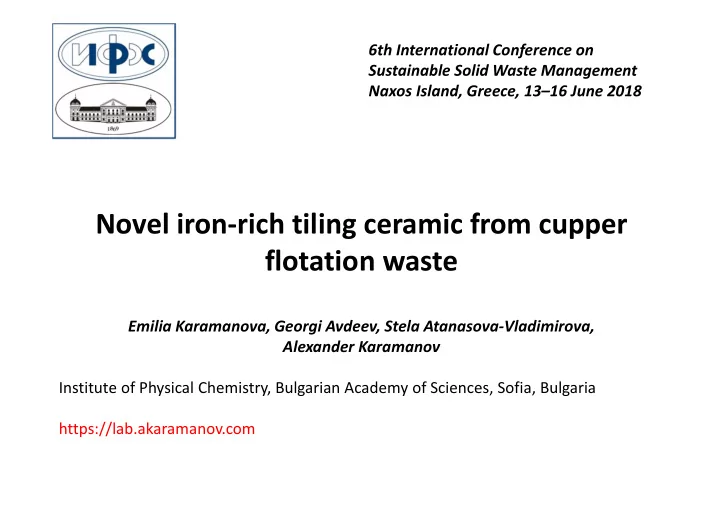

6th International Conference on Sustainable Solid Waste Management Naxos Island, Greece, 13–16 June 2018 Novel iron ‐ rich tiling ceramic from cupper flotation waste Emilia Karamanova, Georgi Avdeev, Stela Atanasova ‐ Vladimirova, Alexander Karamanov Institute of Physical Chemistry, Bulgarian Academy of Sciences, Sofia, Bulgaria https://lab.akaramanov.com
“Aurubis” is the leading integrated copper group and the world’s largest copper recycler. “Aurubis – Bulgaria”, Pirdop (ex ‐ ”Georgi Damianov” and ex ‐ “Cumerio”) becomes a part of the group in 2005. Today this plant is one of the biggest industrial units is Bulgaria. Production volume per year: copper cathodes (99.99 % Cu) ‐ 300 000 t sulfuric acid ‐ 1 300 000 t iron silicate (main residue) ‐ 700 000 t
Tiling ponds for the “iron silicate ” Possible alternative: Raw material for clicker production • Inert addition for “heavy” concretes • Road gravel • Raw material for ceramics ? •
Chemical composition of the “iron silicate ” wt % Official information Our analysis SiO 2 24.0 ‐ 26.0 19.5 ‐ 20.0 Al 2 O 3 1.0 ‐ 1.5 1 ‐ 1.5 FeO 67.0 ‐ 69.0 78.5 ‐ 79.5 CaO ‐ ‐ MgO ‐ ‐ MO 3.0 ‐ 5.0 1.5 ( CuO, BaO , ZnO ) Na 2 O ‐ ‐ K 2 O ‐ ‐ L.O.I. 2.0 ‐ 3.0 1.0 ‐ 1.5
Separation of fayalite (2FeO.SiO 2 ) from the waste
Ceramic with 35% flotation waste from copper production and 20 % glass cullets F K G F ‐ 35 % in the batch 35% 45% 20% SiO 2 30.3 52.6 71.5 52.5 Al 2 O 3 0.9 33.2 1.5 17.5 FeO* 67.5 0.4 0.2 19.8 CaO 0.2 7.5 3.8 MgO 3.2 1.2 MO 0.8 0.3 0.5 (CuO, BaO , ZnO ) Na 2 O 15.5 4.3 K 2 O 0.3 0.4 0.2 L.O.I. 13.3
HSM test of F ‐ 35
Isothermal sintering at 1160 o C of F ‐ 35
Isothermal sintering at 1260 o C of CFK and CFK – b (MSWA alternate ceramic)
Structure surface fracture
Phase composition
Density and porosity “green” (non fired) final ceramic Bulk density (g/cm 3 ) 2.35 2.29 Skeleton density (g/cm 3 ) 3.06 2.54 Absolute density (g/cm 3 ) 3.06 2.91 Water absorption (%) ‐ 1.2 Closed porosity (%) ‐ 12 Open porosity (%) >25 3 ( by WA )/9 ( by Ar ) g/cm 3 g/cm 3 “green” % ceramic % kaolin 45 2.6 ‐ 2.7 glassy phase 45 ‐ 55 2.3 ‐ 2.4 faylite 35 4.3 ‐ 4.4 hematite 15 ‐ 25 5.2 ‐ 5.3 glass cullet 20 2.5 ‐ 2.6 plagioclase 10 ‐ 20 2.6 ‐ 2.7 The decreasing of absolute density “compensate” ~ 2 firing shrinkage!
Conclusions • Samples of new compositions of building ceramics are obtained using high amounts of cupper flotation waste and glass culets in the batch. • The densification process takes place at low temperature and for a short time. • The obtained samples are characterized by very low open porosity and high crystallinity, which are the main preconditions for good mechanical characteristics. • Due to intensive re ‐ crystallisation processes and formation of new phases with lower densities, the sintering process leads to a negligible firing shrinkage together with acceptable bulk density .
Recommend
More recommend